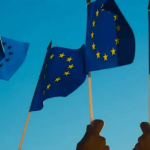How to write an Erasmus Plus project on Adult Education 2020
On Monday December 2, in Milan’s Pirelli Tower, Europe Direct held an info day on KA1 and KA2 projects in the field of Adult Education. L’Orma was present at the info session and we decided to write up the information that was given, to help out organizations and individuals wanting to write projects in the field of Adult Education.
A first important thing to know is that projects in the field of Adult Education can be presented under either a Key Action 1 project or under a Key Action 2. The difference between the two is the scope of the project: KA1 projects typically involve individuals or single organisations wanting to implement a mobility, while KA2 projects involve strategic partnerships aimed at innovation or the exchange of good practices between EU organisations. Below, we describe both types of project in detail before giving you some tips and tricks shared with us by the Italian National Agency.
KA104 projects are mobility projects for adult education staff. Under this call, three different types of mobility can be organized:
- Teaching/training assignments, which allows staff of adult education organisations to teach or provide training at a partner organisation abroad;
- Structured courses or training events abroad, which support the professional development of adult education staff;
- Job shadowing, which provides an opportunity for adult education staff to spend a period of time abroad in any relevant organisation active in the adult education field.
In 2020, the first deadline for KA1 projects is February 5th, and projects submitted under this call can last between 12 and 24 months. The mobilities can last anywhere from 2 to 60 days, depending on the type of mobility. To have your project approved and financed, it needs to get at least 60 out of 100 points and needs to obtain at least 50% of points in the three evaluation subcategories. Importantly, there is no fixed budget under KA104 projects; the budget will depend on the type of mobility chosen.
KA2 projects are bigger in scope, lasting anywhere between 12 and 36 months. They are divided into ‘Innovation’-type projects, and projects aimed at the exchange of good practices. They need to involve 3 partners from at least 3 different EU countries and have a maximum available budget of 450 000 euros. They need to be aimed at at least one of the European Commission’s horizontal priorities, or at one of the field-specific priorities. In 2020, the deadline for these projects is set to March 24th. The types of mobilities supported in these projects (excluding transnational project meetings) are the following:
- Blended mobility of learners, which have to have both a physical and a virtual component, lasting between 5 days and 2 months;
- Long-term teaching of training assignments, which can last from 2 to 12 months;
- Short-term joint staff training events, which can last between 3 days and 2 months.
In the Italian National Agency, approval rates for both types of projects are on the rise due to an increase in the budget allocated to Erasmus+. In 2018, 27 out of 79 KA104 projects were approved, while in 2019 the ratio was 52 out of 86. For KA2 projects, the number of approved projects has steadily been rising as well, from 10 in 2014 to 52 in 2019. Even though there is an increase in budget, applicants should still strive in writing a highly qualitative project proposal. The following section explains exactly how to successfully write an Erasmus Plus project.
Firstly, as with all projects under Erasmus+, it is very important to clearly indicate the added value of submitting the project at the European level and not on a national level. When writing a strategic partnership, this also means clearly explaining the added value of the chosen international partners, and what the impact on both the local and the international level will be for all partners. In this context, it is important to pay enough attention to the partners’ description in the first part of the webform, because you will need to link back to their description and their organisational needs further on.
Once having decided why you want to hold the project under the scope of Erasmus+, it is important to think about the objectives your project wants to reach, and how these align with your organisational needs. Clearly show how the objectives and the different organisational needs are linked, to show how the project will contribute to improving your and your partners’ daily realities.
After explaining the objectives of your project and how they link to your organisational needs, it is important to think about the mobility that you want to insert in the project, if any. Again, you need to demonstrate how the mobility will contribute to reaching the objectives of the project. An important aspect to keep in mind when selecting a mobility activity is to diversify. For example, within a single KA104 project, you could have a member of your staff go on a training course, and then heightened the skills learned on the training course even more by going on a job shadowing. Make sure to not write just a single training course involving half of your staff, because the need for this and its value added is harder to justify.
After having reflected and written about the objectives of the project and how the various activities will contribute to reaching those objectives, it is important to spend enough time on the dissemination and follow-up of you project. The reason for financing such projects is that they should have an impact over the medium- and long-term at all levels (organisational, regional, national and international). Plainly show that you have spent enough time thinking about how you will ensure the continuity of your project, even after its formal end date. Importantly, show that you will not wait with dissemination until the very end of the project: dissemination can start as soon as you have achieved your first results. Importantly, you also have to demonstrate what indicators you will use to measure the project results, both quantitative and qualitative. This part of the project, according to the Italian National Agency, is often the part that most applicants neglect because of time constraints. However, make sure you allocate enough time to this part of the application.
As a last note, especially in strategic partnerships, make sure that the project that you’re writing actually belongs to the Adult Education field of Erasmus+. Often, projects are submitted under Adult Education but actually belong under VET projects instead. The major factor is that projects in the field of adult education are aimed at trainers who work with adults in their daily operation. What does not belong in the field of adult education are mobilities sending an employee abroad to specialize in their own field; this scenario would only work if the employee is an instructor for adults.
With this overview of Erasmus+ projects in the field of adult education, we hope that you feel ready for the upcoming deadlines! If you need additional information on the projects, make sure to consult the Erasmus+ 2020 Program Guide!


